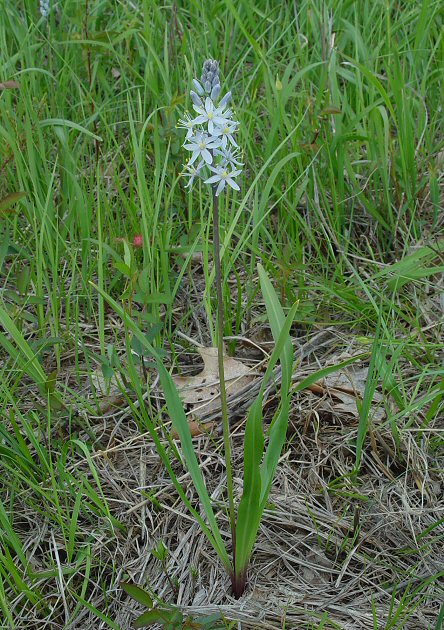Camassia scilloides (Raf.) Cory
Wild Hyacinth

Native
CC = 6
CW = 3
MOC = 75
© DETenaglia
Camassia scilloides (Raf.) CoryWild Hyacinth | |
 |
Native CC = 6 CW = 3 MOC = 75 |
© DETenaglia |
|
Family - Liliaceae Habit - Perennial forb, from a bulb, lacking odor of onion. Stems - Erect, to 75 cm, single and unbranched, glabrous, scapose. Leaves - Basal leaves 20-45 cm long, linear, straplike, flat with a raised midrib underneath, sometimes folded longitudinally in the lower half, glabrous, entire, dull green above, shiny deep green below. Stem leaves 0-2, much reduced, bractlike.
Inflorescence - Terminal raceme, indeterminate, with 7-50 flowers. Flower pedicels subtended by small, linear bracts to 1 cm long.
Flowers - Perianth to 2 cm broad, nectariferous. Tepals free, white, nearly always with some degree of lilac or pale blue shading, with 3-7 nerves, glabrous. Pedicels to 1cm long, elongating in fruit, glabrous. Stamens 6, free, borne at base of tepals. Filaments 6 mm long, glabrous. Anthers yellow, 3 mm long, 1.2 mm broad. Ovary superior, glabrous, 3 mm long, ovoid, with 3 locules, each with 2-5 ovules, placentation axile. Style 1, 3 mm long, glabrous, white. Stigma 3-lobed.
Fruits - Capsules 6-10 mm long, ovoid to obovoid, three-lobed.
Flowering - April - May. Habitat - Open woods, stream banks, glades, bluff ledges, prairies, fields, roadsides. Origin - Native to the U.S. Lookalikes - Camassia angusta. Other info. - This delicately beautiful species is found across most of Missouri, except for the far northwestern and southeastern corners of the state. Its U.S. distribution is restricted to the eastern half of the country. It is probably more abundant in Missouri than any other state. Its showy inflorescences are easily recognized, although can be easily confused with those of Missouri's other member of the genus, C. angusta. The latter species is far less common, and is distinguished by having more flowers on the inflorescence and up to 24 stem leaves.
Photographs taken off Highway 70, Callaway County, MO., 5-3-04 (DETenaglia); also at Shaw Nature Reserve, Franklin County, MO, 4-29-2007, 4-27-2010, 5-14-2022, and 5-17-2022, and Greensfelder County Park, St. Louis County, MO, 4-20-2010, Washington State Park, Washington County, MO, 4-14-2011 and 5-3-2014, and Young Conservation Area, Jefferson County, MO, 5-2-2013 (SRTurner). |